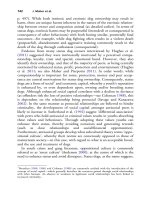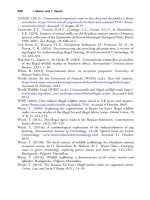The palgrave international handbook of a 296
Bạn đang xem bản rút gọn của tài liệu. Xem và tải ngay bản đầy đủ của tài liệu tại đây (29.08 KB, 1 trang )
Hunting and Shooting: The Ambiguities of ‘Country Sports’
293
killing of animals that the remaining forms of ‘sports shooting’ continue to
encounter—and indeed, as we have seen, which they also appear to provoke.
As part of the wider transcultural civilisation thesis, Elias (1939) has
both depicted the decline of—and the growing opposition to—such popular entertainments as cat-burning and bear baiting while acknowledging
something of a corresponding desire for ‘exciting’ or even visceral encounters with ‘real nature’ (Elias 1986). Thomas (1983) has similarly outlined
the changing human/animal relations, specifically the retreat from anthropocentric thinking (and later, increasing urbanisation), within which
human attitudes towards and treatments of animals were reconstituted.
Tester (1991), likewise, addresses the moral and ideological discourses
within which contemporary notions of ‘animal rights’ are positioned in
respect of latter day ‘green’ thinking and notions of environmental justice.
As, during the late nineteenth and twentieth century, animal cruelty came
to be increasingly regulated and, even more recently, when activities such as
hare coursing and foxhunting with dogs have become prohibited, field
sports shooting (stalking and shooting) remain to bear the brunt of a
popular animosity that is rooted, in part, in a hostility to the notion of
killing for pleasure.2 Of course, although somewhat in the face of the
photographic evidence referred to earlier, shooters often tend to deny the
‘pleasurable’ or ‘exciting’ aspects of their shooting (such as alluded to by
Elias, above), preferring to present shooting as if shooting were a necessary
component of environmental conservation, bio-diversity, sustainable rural
economies and estate management—or at least, as the economic foundation for these more wholesome priorities. In this sense, the popular juxtaposed portraits of proud hunter and vanquished ‘game’3 convey, as Kheel
has argued (1995), such a combination of achievement, entitlement and
domination—the thrill of the chase, the visceral challenge of the wild—as
may be plausibly sustained by any hunter with a high-powered and precision engineered rifle. More fundamentally, Kalof et al. (2004) regard
hunting as an ‘aggressive, powerful and violent’ performance of masculinity. Popular cultural images celebrating hunting, glorifying weapons,
2
As Fukuda has argued, although here specifically in respect of fox-hunting, although the point applies
equally to field sports shooting: ‘The actual and evident reason for people’s participation in fox-hunting
is that they enjoy it, although the content of [this] enjoyment has not been well discussed in public’
(Fukuda 1997, p. 3)
3
Also perpetuating the egalitarian myth that the hunt has been a game – although really, sport for the
one, survival for the other.









